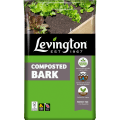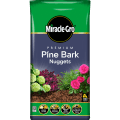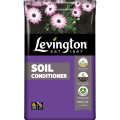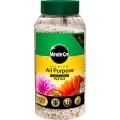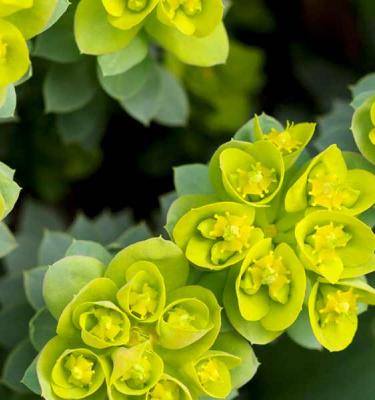

How to grow Euphorbias
Ranging from tender cactus-like succulents to long-flowering architectural plants which make a big impact in your garden, the Euphorbia or ‘spurge’, belongs to the Euphorbiaceae family, made up of over 2000 species. Euphorbias hail from diverse habitats and regions but here we will be looking at the types that can be grown in the UK.
Types of Euphorbias plants to grow
With many Euphorbia varieties to choose from, here is a selection of the most popular and easy to grow Euphorbia plants.
- Euphorbia myrsinites: its creeping habit makes it a useful evergreen ground cover plant with overlapping blue-grey leaves on stems up to 35cm long and clusters of lime green flowers.
- Euphorbia Diamond Frost: is a tender perennial Euphorbia which is often grown as an annual for its tiny white flowers like slivers of ice. Useful for containers and hanging baskets.
- Euphorbia amygdaloides var. robbiae: a low-growing Euphorbia plant (to 50cm) with a spreading habit which copes well with dry shade. Greenish yellow flowers rise from dark evergreen rosettes. Euphorbia amygdaloides var. Purpurea has deep purple leaves and stems, lime green flowers and can reach 1m.
- Euphorbia palustris: the marsh spurge prefers to grow in moist soil in full sun. Growing to between 50cm to 1m, it bears clusters of bright yellow-green flowers in late spring.
- Euphorbia griffithii: distinctive for its orange flowers in early summer, this Euphorbia plant grows to between 50cm and 1m and dies back over the winter. Euphorbia griffithii Fireglow is another red Euphorbia with red-tinged leaves and orange-red flowers.
- Euphorbia x martinii: bearing narrow mid-green leaves and bright lime green bracts with a red eye, this weed-smothering evergreen grows in upright clumps reaching approximately 1m. Euphorbia x martinii Ascot Rainbow has pinkish leaves aging to creamy yellow.
- Euphorbia characias: reaching 1.2m this evergreen Euphorbia has striking spherical or cylindrical flowerheads made up of clusters of purple-lined green flowers with bright yellow centres. Euphorbia characias subsp. Wulfenii is similar but without the purple colouring.
- Euphorbia mellifera: the honey spurge is a handsome shrub from Madeira up to 2m tall with brown honey-scented flowers in late spring.
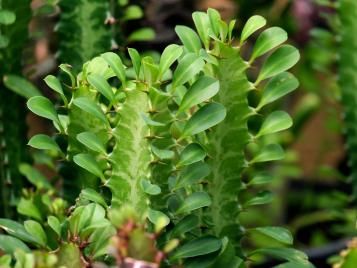
What you’ll need to grow Euphorbias
Euphorbias grow in most types of soil as long as it is fertile and well drained. If your soil is heavy clay, improve drainage by introducing some border soil improver. For more free-draining soils, add some well-rotted manure to the planting hole to enrich the soil and help to retain nutrients. Smaller forms of Euphorbia can be planted in large containers, using peat-free compost.
Where to plant and place your Euphorbias
There are many different Euphorbias for different parts of the garden, some tall, some low growing and creeping. Always make sure you choose the right variety for your garden. All Euphorbias however do like a sunny site.
The succulent, silver leaved varieties such as Euphorbia myrsinites like a sunny position in a rockery or in well-drained soil at the front of a border. Choose a sunny location for Euphorbia characias and other Euphorbias with grey-green foliage indicating their Mediterranean origin. Woodland spurges such as Euphorbia x martinii, Euphorbia amygdaloides var. robbiae and Euphorbia amygdaloides var. purpurea prefer shadier conditions. Allow plenty of space for the taller growing varieties like Euphorbia mellifera by placing them at the back of a sunny border where they have room to spread and be displayed to best advantage.
Caring and nurturing your Euphorbias
Follow these Euphorbia care tips for successful growing:
- Plant in full sun or, for the wood spurge types like Euphorbia amygdaloides, in semi-shade.
- Mulch each year, in early spring, with leaf mould such as Fibre Smart Mulch or well-rotted manure.
- Water well after planting.
- Euphorbias grow well in all soil types.
- Wear gloves and long sleeves when pruning Euphorbias to avoid contact with the milky sap which causes skin irritation. After flowering, deadhead the herbaceous perennials like E. cyparissias, E. griffithii and E. palustris. Cut down Euphorpia characias and Euphorbia myrsinities to ground level after flowering, to encourage fresh re-growth. Cut the flowering shoots of Euphorbia mellifera down to the base of the plant in late summer and autumn.
- Re-pot Euphorbias grown in containers every few years in fresh peat free compost.
- After cutting back you can take softwood cuttings - just make sure you wear gloves. You can also divide the herbaceous perennials after flowering, again wearing gloves.
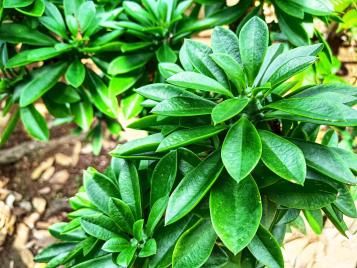
Common pests and diseases with Euphorbias
Euphorbias are pretty resistant to pests and diseases, although sometimes powdery mildew can be a problem. Vigorous clump formers like E. amygdaloides and E. cyparissias ‘Fens Ruby’ can become invasive if not cut back when they become too vigorous.
Frequently asked questions about Euphorbias
Is Euphorbia poisonous to cats, dogs or humans?
Yes. If ingested, all parts of Euphorbia plants will cause severe discomfort to humans and their pets. Contact with the sap will irritate skin and eyes. Wash off immediately and stay out of the sun if you get sap on your skin.
Do Euphorbias need full sun?
Yes, most Euphorbias like to grow in full sun but some woodland species of Euphorbia prefer shade, such E. amygdaloides var. robbiae.
How often should I water Euphorbia?
Water newly planted Euphorbias well in dry spells during their first two growing seasons. Don't allow the compost to dry out in container-grown Euphorbias.
What should I plant with Euphorbia?
Purples and mauves work well with the lime green of many Euphorbias. Combine E. x martinii with Salvia nemorosa Caradonna or Allium Purple Sensation. The redder shades of E. griffithii Fireglow contrast in form and texture with the blue-grey leaves of Melianthus major.
Key features of Euphorbias
| Botanical Name | Euphorbia species |
|---|---|
| Plant Type | Shrubs or herbaceous perennials |
| Family | Euphorbiaceae |
| Light Exposure | Full or partial sun, partial shade for woodland varieties |
| Soil pH | Acid, alkaline, neutral |
| Flowering Time | Spring and summer |
| Flower Colour | Lime green, yellow, light green, orange |
| Toxicity | Severe discomfort if eaten and the milky sap causes skin irritation |
